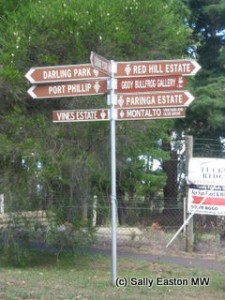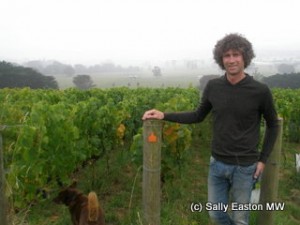Australia's new cool

Mornington ridge
A version of this article first appeared in the Drinks Business magazine, May 2012 issue.
Australian cool viticultural climates can generally be found at higher altitudes or latitudes. Many have climbed in search of cooler zones such as the Macedon Ranges, Adelaide Hills, Whitlands at the Alpine end of King Valley, and the Upper (south) Yarra Valley. But maritime areas, especially those exposed to cool, Southern Ocean currents in the Bass Strait as it funnels across lands south of Melbourne, also find cool, and windy, locations. Island state Tasmania gets the double whammy of a high latitude location that is bang in the middle of the roaring forties trade winds.
Using GST, cool climate wine styles from noble grape varieties start with fruit for sparkling wine – predominantly chardonnay and pinot noir. Witness the UK where half the fruit grown now channels into various sparkling wine programmes. In Tasmania, some 40% of total tonnage goes down the sparkling wine route.
Given that vintage varies significantly in marginal cool climates, it helps to keep the winemaking options open. Fran Austin of Delamere Vineyards in Pipers Brook region of Tasmania, said “you’re on the edge of what a vine is comfortable growing in” but, she said “Tasmania is either a good or a great year for sparkling, (though) for still wine in this region, you have to be careful with site selection.” Delamere is a very late site for still pinot noir, so Austin said “we can always make the decision to put to sparkling. There are probably two years in ten where we’d push more [fruit] towards sparkling.”
While Tasmania is professionally growing into its role as Australia’s cool climate state, on the mainland at slightly lower latitudes, but still influenced by the oceans, west and south Gippsland, to the south east of Melbourne, are looking like the next new cool locations. Swathes of Gippsland fall into a GST of 14 to 16°C.
As Mornington Peninsula gets increasingly expensive this area is setting itself up to be the undiscovered weekend destination for Melbournites. It may be another half hour or so further out than Mornington Peninsula, but the roads are quieter. With slightly more warmth from lower latitude, the grape varieties are still pinot noir and chardonnay, but wine styles have moved from sparkling to still wine.

Bill Downie
Bill Downie is the new poster boy for Gippsland, having bought and planted a plot in the west a few years ago. He said “for as long as I’ve worked in wine I’ve wanted to own this patch of land.” Having grown up nearby he’s had plenty of time to figure out why it is so good for the “brighter, more pristine fruit” that he wants to make: “Gippsland is cooler and wetter than the Côte d’Or, by heat degree days, mean temperature of the warmest month and rainfall measurements. But the tail end of the season is different, we get warm days” to ripen fruit.
Arguably Gippsland’s most famous grower is Bass Phillip, located 150km south east of Melbourne in south Gippsland, where he set up in 1979. Phillip Jones’ pinot noirs have long been critically acclaimed for their texture, complexity and longevity.
More recently other growers have become active in the prime dairy and pastureland of south Gippsland, and now there are some 20 growers making their own wine in this cool, maritime climate. Its feel is not dissimilar to the early pioneering spirit of Tasmania, with small vineyards and increasing levels of professionalism rushing in. Neil Travers of Waratah Hills estimates 80% of the area’s vineyard is planted to pinot noir and chardonnay.
While the Strzeleki Ranges might provide a bit of wind protection for Downie’s vineyard on their leeward side a bit to the north, winds associated with the Southern Ocean and Bass Strait are a huge feature on viticulture in coastline regions. South Gippsland is on the windward side of the Strzelecki Ranges. Mornington Peninsula is fully exposed.
Indeed the peninsula has sea influences on three sides, which gives rise to a minutiae of vineyard variation. Cheryl Lee, executive officer of Mornington Peninsula Vignerons’ Association, said “we have water on three sides. We have breezes from three directions” adding cold, “rugged winds come right off the Bass Strait from the south” plus there are plenty of afternoon breezes from Western Port Bay and Port Phillip Bay.
Lee put to one side the altitude argument for sub-regionality that is often discussed in the peninsula, saying “two vineyards at the same altitude might have three weeks difference in picking dates.” Original Peninsula pioneer, Nat White, of Main Ridge agreed saying “altitude is not everything. We’re cooler and higher but it is to do with the prevailing winds. There are anomalies of some vineyards at low altitude picking as late as us because of the westerly winds which are cool.”
White added “our picking dates are about the same as Pipers River. The altitude here [230m] makes up for Pipers River more southerly location. Places around Hobart are warmer than here.” The GST for west-east running main ridge across the south of Mornington Peninsula is 15.4°C – bang in the middle of ‘cool’.
Stylistically the cool climate indicative varieties pinot noir and chardonnay are totally dominant in the peninsula, accounting for 85% of the about 900 hectares of vineyard.
Such coolness of different sites on the peninsula has given rise to the creation of a trend to delineate cool fruit expression in the wine by ‘extreme’ picking on chardonnay, aiming to vinify in a notably lean, steely style, using minimal overt oak to fatten the flavours, and additionally often preventing the malolactic fermentation to accentuate the bony style.
Such a style needs coolness of location to work. Prime proponent Mike Aylward, of Ocean Eight, said “we pick chardonnay just past sparkling base. I want grapefruit, lemon and lime, not stone fruit. I like to get flavours from lees rather than ripe fruit flavours or oak. His aim for the then imminent 2012 was to “pick the chardonnay at around 11.7 Baumé, with around 8.5 g/l acid and 3.2 pH. As soon as the flavours leave green apple and go to grapefruit, we’ll pick it. If it’s still green at 12 Baumé, we won’t pick it.”
Cool climate clearly suits certain grape varieties, but wine style has to come into any definition, because pinot noir and chardonnay can be grown in temperate and hotter climates. Pirie defines cool climate style as “delicacy but richness of flavour at the same time.” A full expression of aromatic potential and freshness of acidity might be added, but that’s probably another discussion.
My research visit to Australia in February 2012 was sponsored by Wine Australia and Wine Tasmania.



